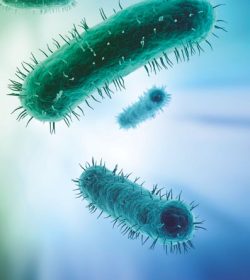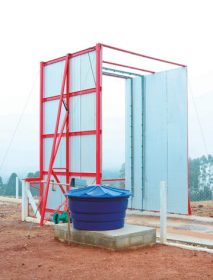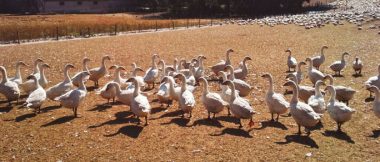Content available at: Indonesia (Indonesian) Melayu (Malay) ไทย (Thai) Tiếng Việt (Vietnamese) Philipino
In the context of animal health, the prophylaxis of infectious diseases in poultry populations, whether for prevention or control, is always directed at the population of a given geographical area (Animal Health) or at poultry facilities (Veterinary Preventive Medicine/Biosecurity) and the fundamental requirement for its implementation is the knowledge of epidemiology of transmissible diseases.
It is the science that studies the mechanisms of disease transmission in animal populations and the prophylaxis measures which, for their application, it is necessary to know the etiological agent involved, the host, and the environment.
It is the ability to solve problems with learning how to think and not what to think to outline a poultry health program.

Without epidemiology there is no scientific basis for the practice of Animal Health and Biosecurity.
- The focus of the clinician is the sick animal, it is like looking at a sick tree. Its purpose is treatment.
- The focus of pathology is a part of the animal (macroscopic and microscopic lesions, blood serum, organ fragments) with the objective of studying the path that a pathogenic agent travels in the organism of an infected or diseased animal. It is like looking at the wood of a diseased tree.
- The focus of epidemiology is the environment where the animals live (farm) and the surroundings where the risk factors are present (freeranging wild and domestic animals) livestock farms, water sources (rivers, lakes, reservoirs), sanitary landfills, garbage dumps, rodents, insects, etc.

Therefore, biosecurity measurements refer to actions in different components of the environment.
A disease control program must be well designed both biologically (effectiveness) and economically (efficiency). It must also be dynamic in order to evolve according to changes in the situation as assessed by the frequency of occurrence of the disease/ infection, economic conditions (costbenefit), political or socio-climatic that require a change in the course of the program.
The subject matter of this document are the commercial poultry without specific emphasis in the different alternative modalities such as free-range broilers, commercial cage-free laying hens.

CONSIDERATIONS ON THE RELATIONSHIP BETWEEN ETIOLOGY, HOST AND ENVIRONMENT
Etiological agents
They will be mentioned simply as pathogens or agents of enteritis because in the epidemiological approach they will be treated as agents of enteric diseases, despite the fact that each agent is represented by innumerable species. They are characterized by being eliminated through the feces, being highly resistant to environmental conditions in which they remain viable for months, and entering the organism of a new host through the beak, hence the term fecal-oral transmission diseases.
Hosts
Enteritis agents lack host specificity. This knowledge gives us scientific authority to control the set of agents that cause enteric syndrome in a population and invalidates any control procedure directed at one or a few etiologic agents. Taking Salmonellae alone as an example, they have been found to infect more than 2,600 species of cold and warm-blooded hosts.

Environment
The host-parasite relationship is modulated by the environment in its most diverse components, such as socioeconomic conditions (poverty and wealth; level of education), climate, nature of the soil, vegetation, forests (presence of predatory animals, wild birds, wild animals), nature of the animal exploitation (poultry breeding only or mixed with other animal species), presence of free range and backyard farms, etc. The balance of the host-parasite relationship is achieved when the environment favors poultry production that is the object of the program and when it is unfavorable, poultry farming faces an increase in the occurrence of diseases and the damages become evident.
It should be noted that in disease prophylaxis (eradication, prevention and control) measurements are applied to the different components of the environment.
When prophylaxis measurements balance the defensive forces of the host and the offensive forces of the environment, disease manifests itself at a controlled level, as shown in the figure below, and productivity is not compromised. The balance between the plates illustrates the balance between the defensive forces of the host and the aggressive forces of the environment.

The chain of transmission or epidemiological chain consists of the following links:
SOURCE OF INFECTION
Domestic and free-living birds, including wild birds that harbor the parasite in their organism and release it into the environment. They can be sick, carriers (healthy, incubating or convalescents and reservoirs) -birds of other species and domestic and wild animals.
DISPOSAL ROUTES
Ways or vehicle used by the parasit to reach the environment. It is the feces.
ROUTES OF TRANSMISSION
Means or vehicles used by the parasite to enter the new host. They are water, food, bedding, flies, beetles, boots, hands contaminated by the parasite.
ENTRANCE DOOR
Access of the parasite to the new host, which is the mouth.
SUSCEPTIBLE
New host to be infected.
Note
In the absence of e fective control measures, this cycle repeats itself indefi nitely in the population, resulting in a gradual increase in prevalence.

PROPHYLAXIS MEASURES
Measures relating to sources of infection
Treatment of poultry when appropriate and removal of lot when established by legislation (salmonella).
Measures related to transmission routes
Fences on the walls to prevent animals from entering outside the hatchery; sanitary barrier (sanitary gate) and hygiene of employees and visitors); cleaning of areas outside the shed (emphasis on rodents and flies); complete drinking water treatment, storage and distribution
networks; proper waste collection and disposal and dead animals; cleaning and disinfection of the floor, feeders, drinking fountains, curtains in the sanitary void; beetle control in the sanitary vacuum; Prevention and control of pests (rodents, flies and beetles during lodging).
Measures relating to susceptible
Vaccinations when available.
OUTLINING AN ENTERIC SYNDROME CONTROL PROGRAM – BIOSECURITY:
1. GUIDELINE
Definition of initial, intermediate and final objectives. Drafting of the Procedures Manual and preparation of standard operating procedure (SOP) sheets;
- Initial objective: introduce biosecurity measures;
- Intermediate objective: reduce morbidity and/ or mortality and increase productivity;
- Final objective or purpose: improve the health conditions of the birds.
2. EXECUTION
Preparatory phase: gathering all the elements to achieve the objective such as cost estimation, employee selection, assignment of responsibilities, employee training, training of veterinarians in epidemiology (basic and special) and biostatistics. It is recommended that
training should conform to modern quality principles, including self-monitoring.
Attack phase: continuous and systematic application of procedures. It involves periodic evaluation to correct the course.
Consolidation phase: to reach the final objective, adjusting biosecurity measures to prevent the reoccurrence of infections or diseases.
Maintenance phase: continuation of the previous phase, but integrating it into the Animal Health Plan of the establishment or zone.

Evaluation: carry out periodic evaluations, not only by performing laboratory tests to assess the presence or absence of the pathogen, but mainly through statistical analysis of health indicators (morbidity, mortality); production indicators.
The statistical tests are quite simple, such as the test of difference between proportions for qualitative variables and the test of difference between averages for quantitative variables, always establishing, a priori, the level of rejection of the null hypothesis (α ou p).
Components of biosecurity measures: conceptual biosecurity, operational biosecurity, and structural biosecurity.
Conceptual biosecurity: refers to the prevention or control measures against hazards in the environment to delimit the measures related to the fence and sanitary gate.
Structural biosecurity: refers to prevention or control measures against hazards present in facilities, objects, utensils, bedding, pests, etc.
Operational biosecurity: refers to hygiene measures to internal staff, visitors, subcontracted and permanent staff.










